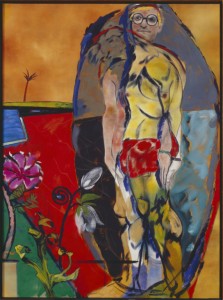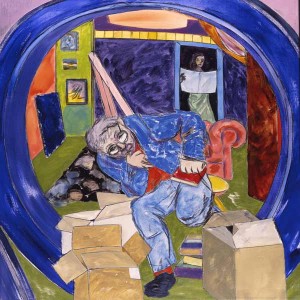
R.B. Kitaj, The Neo Cubist, 1976-1987 © R.B. Kitaj Estate, Astrup Fearnley Collection, Oslo, Norway
On the 19th of October, just past 8 pm, I received the message “David is breaking away from his installation in Köln and will arrive at the Jewish Museum on Sunday 21st. between 11. – 11.30 am.”
Some time before, I had contacted the gallerist Peter Goulds to ask whether David Hockney might be interested in coming to Berlin to visit the R.B. Kitaj exhibition; I knew Hockney would be in Cologne to open his own exhibit “A Bigger Picture” at the Museum Ludwig. Though it seemed unlikely at first, Hockney was able to come. He brought his partner, his studio manager, and a chauffer, and appeared wearing an elegant grey double-breasted suit, a black Hawaii shirt with fantastic plants on it and a checked flat cap.
→ continue reading
Kitaj once said that books are for him what trees are for a landscape painter. His ateliers in the London neighborhood of Chelsea and in Westwood, Los Angeles, were crammed full of books, on shelves, around his easels and piled up on the floor.

R.B. Kitaj, Unpacking my Library, 1990-1991 © R. B. Kitaj Estate
He was already ranging through the cheap bookshops on 4th Avenue – the largest bookselling district in the world – on his way to Cooper Union when he was a student there. He found the modern classics like James Joyce, Ezra Pound, T.S. Eliot, and Kafka, as well as journals such as the “Partisan Review” and the American surrealist magazine “View.” In Oxford, his teacher Edgar Wind introduced him to the Warburg School and he bought a complete set of the famous “Journals of the Warburg Institute.” His visual imagination was fuelled by the illustrations for the “Afterlife of Antiquity,” copperplate engravings made according to ancient templates. In 1969, Kitaj published as silkscreens 50 book jackets from his personal library, in an edition that he called “In Our Time: Covers for a Small Library after the Life for the Most Part.” → continue reading

